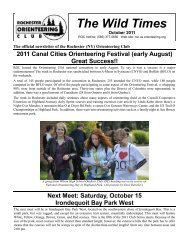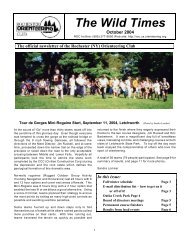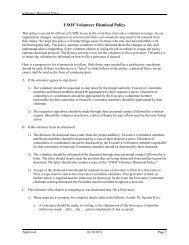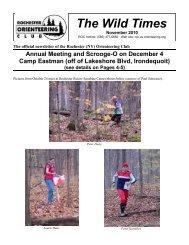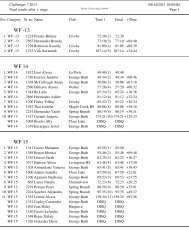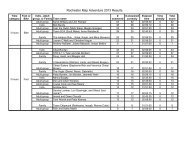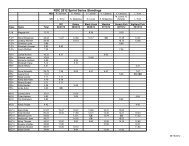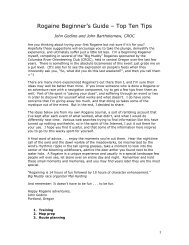A Rules for Foot Orienteering Events - Orienteering USA
A Rules for Foot Orienteering Events - Orienteering USA
A Rules for Foot Orienteering Events - Orienteering USA
You also want an ePaper? Increase the reach of your titles
YUMPU automatically turns print PDFs into web optimized ePapers that Google loves.
G.1.5 Daily Ranking credits are only used to qualify <strong>for</strong> annual ranking by those<br />
otherwise unable to meet the required number of races. Daily ranking credits are<br />
obtained from:<br />
a) Administration of a day of an <strong>Orienteering</strong> <strong>USA</strong> sanctioned A-meet in<br />
such a capacity that, at the discretion of the meet director, the person<br />
cannot physically or fairly enter the event.<br />
b) Being assigned a "Sporting Withdrawal (SPW)” <strong>for</strong> assisting in an<br />
emergency or as determined by the jury as in sections or .<br />
c) Starting a course that is voided by meet officials.<br />
d) Completing a course at an <strong>Orienteering</strong> <strong>USA</strong> sanctioned class A-meet that<br />
does not meet the requirements of G.1.2a, such as a Relay.<br />
e) Completing a course at an <strong>Orienteering</strong> <strong>USA</strong> sanctioned class A-meet that<br />
has fewer than five finishers (three <strong>for</strong> white and yellow courses). These<br />
courses will not yield statistically significant ranking results so will not<br />
count numerically towards a ranking score.<br />
G.1.6 No more than two credit days may be used toward qualification <strong>for</strong> annual<br />
ranking.<br />
G.1.7 Calculation of annual ranking points are as follows:<br />
a) For each qualifying person, take their best 4 daily ranking point days plus<br />
1/2 of the remaining ranking point days (e.g., if 5 races are run, the top 4 +<br />
[1/2 x 1] = 4.5 races are ranked), and average them to the nearest tenth of a<br />
point. Competitors who need credits (Section G.1.5) to meet their<br />
minimum requirements will have the points from all their point qualifying<br />
competitions (Section G.1.2) on courses of one color averaged <strong>for</strong> their<br />
ranking in their class on that color course.<br />
b) Next, determine the top three ranked individuals on the course <strong>for</strong> the<br />
year, average their annual ranking points, and divide the result into 100,<br />
calling the result the Normalization Factor (NF). Multiply the ranking<br />
points of everyone ranked on the course by NF to determine their final<br />
ranking points, to the nearest tenth of a point.<br />
c) Finally, separate the persons on the course into their classes and list them<br />
in order.<br />
G.1.8 Persons who qualify <strong>for</strong> ranking on a course will be ranked in the class on the<br />
course that is nearest their own age, regardless of the class(es) they actually ran.<br />
G.1.9 A person may receive annual rankings on two different courses, provided that on<br />
one of the courses, they obtain daily ranking points (no credits) <strong>for</strong> the full<br />
number of days needed <strong>for</strong> ranking, else they will only receive ranking on the<br />
course and class nearest their own <strong>Orienteering</strong> <strong>USA</strong> age class. If they meet these<br />
more stringent requirements on one course, the second course need only meet the<br />
normal requirements.



